You can Download Chapter 14 Biomolecules Questions and Answers, Notes, 2nd PUC Chemistry Question Bank with Answers Karnataka State Board Solutions help you to revise complete Syllabus and score more marks in your examinations.
Karnataka 2nd PUC Chemistry Question Bank Chapter 14 Biomolecules
2nd PUC Chemistry Biomolecules NCERT Textbook Questions
Question 1.
What are monosaccharides?
Answer:
Monosaccharides are carbohydrates which cannot be hydrolysed to smaller molecules. Their general formula is (CH2O)n where n = 3 → 7. These are of two types. Those which contain an aldehyde (-CHO) group are called aldose and those which contain a keto (C = 0) group are called ketose. They are further classified as triose, tetrose, pentose etc. according to the no. of carbon atoms present (3, 4, 5 respectively).
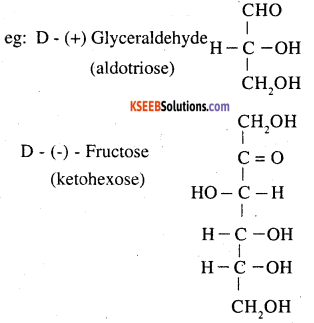
![]()
Question 2.
What are reducing sugars?
Answer:
Carbohydrates which reduce Fehling’s solution to red p.pt of Cu2O or Tollen’s reagent to shining metallic Ag are called reducing sugars. All monosaccharides (both aldoses and ketoses) and disaccharides except sucrose are reducing sugars.
Question 3.
Write two main functions of carbohydrates in plants.
Answer:
1. Structural material for plant cell walls: The polysaccharides cellulose acts as the chief structural material of the plants cell walls.
2. Reserve food material: The polysaccharide starch is the major reserve food material in the plants. It is stored in seeds and acts as the reserve food material for the tiny plant till its capable of making food on its own by photosynthesis.
Question 4.
Classify the following into monosaccharides and disaccharides.
Ribose, 2-deoxyribose, maltose, galactose, fructose and lactose.
Answer:
Monosaccharides: Ribose, 2-deoxyribose, fructose.
Disaccharides: maltose, galactose, lactose.
Question 5.
What do you understand by the term glycosidic linkage?
Answer:
The oxygen linkage through which two monosaccharides are joined together by the loss of a water molecule to form a molecule of disaccharide is called the glycosidic linkage. The glycosidic linkage in maltose molecule is shown below.
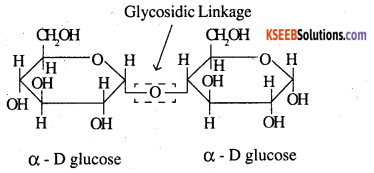
Question 6.
What is glycogen? How is it different from starch?
Answer:
Glycogen like starch is a condensation polymer of α – D glucose. Just as glucose is stored in plants in the form of starch it is stored in the form glycogen in human beings. It is present in liver, muscles and brain. When body needs glucose, enzymes breakdown glycogen to provide glucose. It is also present in yeast and fungi.
The main difference between glycogen and starch is that starch is made up of amylose and amylopectin where as glycogen consists of a structure almost same as amylopectin with large number of branching, (amylose has a linear structure and amylopectin has a branched structure with branching after every 25-30 molecules). Glycogen has branching after every 10-15 molecules.
Question 7.
What are the hydrolysis products of
(i) sucrose and (ii) lactose?
Answer:
Both sucrose and lactose are disaccharides sucrose on hydrolysis gives one molecule of α – D glucose and one molecule of β – D – fructose but lactose on hydrolysis gives one molecule of β – D glucose and one molecule of β – D galactose.
Question 8.
What is the basic structural difference between starch and cellulose?
Answer:
Starch is not a single component. It consists of amylose and amylopectin. In contrast, cellulose is a single compound. Amylose is a linear polymer of α – D glucose while cellulose is a linear polymer of β -D glucose. In amylose, C1 – C4 α- glycosidic linkage is present, whereas in cellulose C1 – C4 β- glycosidic linkage is present. Amylopectin has a highly branched structure.
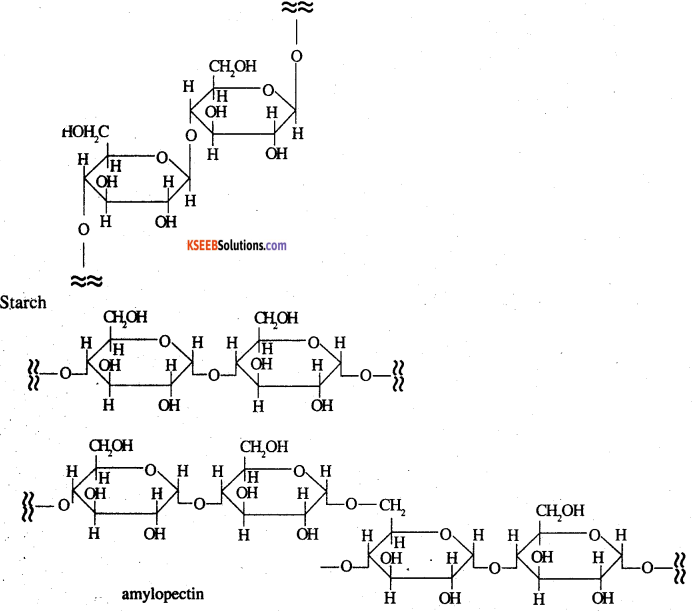
![]()
Question 9.
What happens when D-glucose is treated with the following reagents?
(i) HI
(ii) Bromine water
(iii) HNO3
Answer:
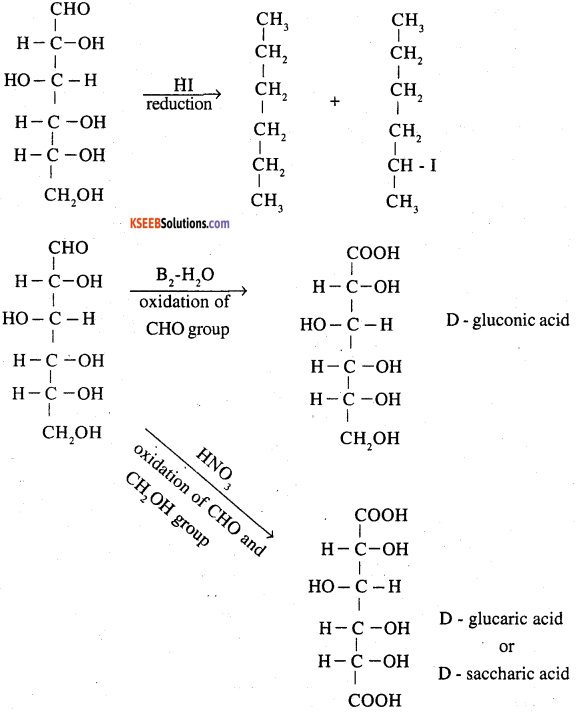
Question 10.
Enumerate the reactions of D-glucose which cannot be explained by its open chain structure.
Answer:
The following reactions of D- glucose cannot be explained by its open chain structure.
1. D – glucose does not undergo certain characteristic reactions of aldehydes. For example glucose does not form NaHSO3 addition product, aldehyde-ammonia adduct, 2, 4, DNP derivative and does not respond to Schiff’s reagent test.
2. Glucose reacts with NH2OH to form an oxime but glucose pentaacetate does not. This implies that the aldehyde group is absent in glucose pentaacetate.
3. D (+) – Glucose exists in two stereoisomeric forms ie. α – glucose and β- glucose, α – D (+) – glucose is obtained when a concentrated aqueous or alcoholic solution is crystallised at 303K. It has a melting point of 419K and has a specific rotation of +111° in a freshly prepared aqueous solution. However when glucose is crystallised from water above 371 K β – D (+) glucose is obtained.
4. Both α – D glucose and β – D glucose undergo mutarotation in aqueous solution.
Question 11.
What are essential and non-essential amino acids? Give two examples of each type.
Answer:
α – Amino acids which are needed for health and growth of human beings but are not synthesised by the human body are called essential amino acids. For example, valine, leucine phenylalanine etc. On the other hand α – amino acids which are needed for health and growth of human beings and are synthesised by the human body are called non-essential amino acids. For example glycine, alanine, aspartic acid etc.
Question 12.
Define the following as related to proteins
1. Peptide linkage
2. Primary structure
3. Denaturation.
Answer:
1. Peptide linkage: Proteins are condensation polymers of α – amino acids in which the same or different α – amino acids are connected by peptide bonds. Chemically, a peptide bond is an amide linkage formed between – COOH group of one a – amino acid and – NH2 group of the other α – amino acid by loss of a molecule of water. Example
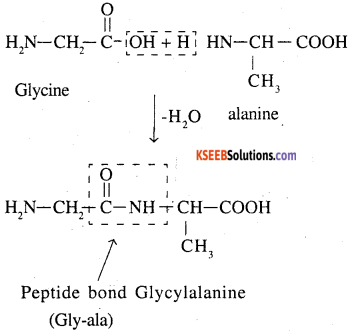
![]()
2. Primary structure: Proteins may contain one or more polypeptide chains. Each polypeptide chains has a large number of α – amino acids which are linked to one another in a specific sequence. The specific sequence in which the various α – amino acids present in a protein are linked to one another is called its primary structure. Any change in the sequence of α – amino acids creates a different protein.
3. Denaturation: Each protein in the biological system has a unique 3-D structure and has specific biological activity. This is called the native form of the protein. When a protein in its native form is subjected to physical changes like change in temperature, pH etc. hydrogen bonds are broken. Due to the cleavage of hydrogen bonds, unfolding of the protein molecule takes place and it looses its biological activity.
This loss of biological activity is called Denaturation. During denaturation 2° and 3° structures are destroyed but 1° structure remains intact. As a result of denaturation, globules proteins are converted into fibrous proteins. In other words denaturation leads to coagulation. That is why coagulated proteins are called denaturated proteins. Example boiling of egg causes coagulation of egg white.
Question 13.
What are the common types of secondary structure of proteins?
Answer:
The conformations which the polypeptide chains assume as a result of hydrogen bonding is called the secondary structure of proteins. The two types of secondary structures are α -helix and β -pleated sheet structure.
α -helix structure:- In this structure, the -NH group of an amino acid residue forms H-bonds with the > c = o group of the adjacent turn of the right handed screw. (α – helix)
β – pleated.sheet structure:- This structure is called so because it looks like the pleated folds of a drapery. In this structure, all the peptide chains are stretched out to nearly the maximum extension and the then laid side by side. These peptide chains are held together by inter molecular hydrogen bonds.
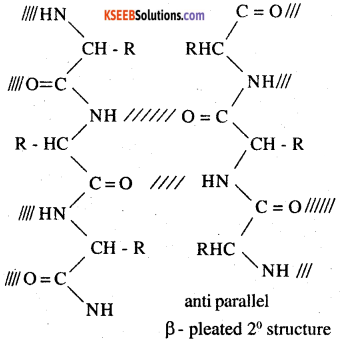
Question 14.
What type of bonding helps in stabilising the a -helix structure of proteins?
Answer:
The H – bonds formed between the NH group of each amino acid residue and the
![]()
group of the adjacent turns of the α – helix help in stabilising the helix.
Question 15.
Differentiate between globul and fibrous proteins.
Answer:
| Fibrous protein | Gloublar protein |
| 1. It is a fibre like structure formed by the polypeptide chain. these proteins are held together by strong hydrogen and disulphide bonds | 1. The polypeptide chain in the protein is folded around itself, giving rise to a spherical structure |
| 2. It is insoluble in water | 2. It is usually soluble in water |
| 3. Fibrous protein usually used for example, keratin it Present in nails and hair collagen in undoms and myosin in muscles. | 3. All enzymes are globular proteins. some hormone such as insulin are also globular proteins |
Question 16.
How do you explain the amphoteric- behaviour of amino acids?
Answer:
In aqueous solution, the carboxyl group of an amino acid can loose a proton and the amino group can accept a proton to give a dipolar ion known as zwitter ion
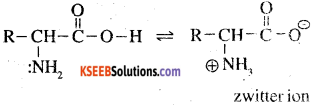
Therefore, in zwitter ion form, the amino acid can both as an acid and a base.

Thus, amino acids show amphoteric behavior.
![]()
Question 17.
What are enzymes?
Answer:
Enzyme are proteins that catalyse biological reactions. They are very specific in nature and catalyse only a particular reaction for a particular substrate. Enzymes are usually named after the particular substrate or class of substrate and some times after the particular reaction.
For example: The enzymes used to catalyse the hydrolysis of maltose into glucose is named as malase.
![]()
Again, the enzymes used to catalyse the oxidation of one substrate with the simultaneous reduction of another substrate are named as oxidoreductase enzymes. The name of the enzyme ends with 4- ase’.
Question 18.
What is the effect of denaturation on the structure of proteins?
Answer:
As a result of denaturation, globules get unfolded and helixes get uncoiled. Secondary and tertiary structures of protein are destroyed, but the primary structures remain unaltered. It can be said that during denaturation, secondary and tertiary – structured proteins get converted into primary – structured proteins. Also, as the secondary and tertiary structures of a protein are destroyed, the enzyme loses its activity.
Question 19.
How are vitamins classified? Name the vitamin responsible for the coagulation of blood.
Answer:
On the basis of their solubility in water or fat, vitamins are classified into two groups:
1. Fat – soluble vitamins:
Vitamins that are soluble in fat and oils, but not in water, belong to their group.
For example: Vitamins A, D, E and K.
2. Water – soluble vitamins:
Vitamins that are soluble in water belong to their group.
For example: B group vitamins (B1, B2, B6, B12, etc) and vitamin C.
However, biotin or vitamin H is neither soluble in water nor in fat.
Vitamin K is responsible for the coagulation of blood.
Question 20.
Why are vitamin A and vitamin C essential to us? Give their important sources.
Answer:
The deficiency of vitamin A leads to xerophthalmia (hardening of the cornea of the eye) and night blindness. The deficiency of vitamin C leads to scurvy (blending gums). The sources of vitamin A are fish liver oil, carrots, butter and milk. The sources of vitamin C are citrus fruits, amla and green leafy vegetables.
Question 21.
What are nucleic acids? Mention their two important functions.
Answer:
Nucleic acids are biomolecules found in the nuclei of all living cells, as one of the constituents of chromosomes. There are mainly two types of nucleic acids- deoxyribonucleic acid (DNA) and ribonucleic acid (RNA). Nucleic acids are also known as polynucleotides as they are long- chain polymers of nucleotides.
Two main functions of nucleic acid are.
1. DNA is responsible for the transmission of inherent characters from one generation to the next. This process of transmission is called heredity.
2. Nucleic acids- (both DNA and RNA) are responsible for protein synthesis in the cell. Even though the proteins are actually synthesised by the. various RNA molecules in a cell, the message for the synthesis of a particular protein is present in DNA.
Question 22.
What is the difference between a nucleoside and a nucleotide?
Answer:
A nucleoside is formed by the attachment of the base to l’ position of sugar.
Nucleoside = Sugar +Base

On the other hand, all the three basic components of nucleic acids (i.e. pentose sugar, phosphoric acid, and base) are present in a nucleotide.
Nucleotide = sugar + Base + Phosphoric acid

Question 23.
The two strands in DNA are not identical but are complementary. Explain.
Answer:
In the helical structure of DNA, the two strands are held together by hydrogen bonds between specific pairs of bases. Cytosine forms hydrogen bond with guanine, while adenine forms hydrogen bond with thymine. As a result, the two strands are complementary to each other.
![]()
Question 24.
Write the important structural and functional differences between DNA and RNA.
Answer:
The structure differences between DNA and RNA are as follows:
| DNA | RNA |
| 1. The sugar moiety in DNA molecules is β-D- deoxyribose. | 1. The sugar moiety in RNA molecules is β-D- ribose. |
| 2. DNA consists Thymine(T), it does not contain uracil (U) | 2. RNA consists uracil (U), it does not contain Thymine(T) |
| 3. The helical structure of DNA is double-stranded | 3. The helical structure of RNA is single-stranded |
The functional difference between DNA and RNA are as follows:
| DNA | RNA |
| 1. DNA is the chemical basis of heredity | 1. RNA is not responsible for heredity |
| 2. DNA molecules do not synthesized proteins, but not transfer coded message for the synthesis of proteins | 2. proteins are synthesized by RNA molecules in the cells. |
Question 25.
What are the different types of RNA found in the cell?
Answer:
- Messenger RNA (m – RNA)
- Ribosomal RNA (r – RNA)
- Transfer RNA (t – RNA)
2nd PUC Biomolecules Additional Questions
Question 1.
What are the expected products of hydrolysis of lactose ?
Answer:
Lactose is a diasacharide on hydrolysis, it gives two molecules of monosaccarides, i.e. one moiecule of each of D – (+) galactose.

Question 2.
Fresh tomatoes are a litter source of vitamin C than those which have been stored for some -time. Explain.
Answer:
On prolonged exposure to air, vitamin C present in tomatoes is destroyed due to aerial oxidation.
Question 3.
Name the vitamin responsible for poor coagulation of blood due to deficiency.
Answer:
Vitamin K.
Question 4.
Ka and Kb values of α – amino acids are very low. Explain. +
Answer:
The Ka and Kb values of α – amino acids, the acidic group is -NH3 instead of -COOH in carboxylic acids and basic group is -COO instead of NH2 group in aliphatic amines.
Question 5.
Two samples of DNA, A and B have melting temperature (Tm) 340 and 350k respectively. Can you draw any conclusion from these data regarding their base content?
Answer:
We know that CG base pair has 3 H-bonds and AT base pair has two H-bonds, therefore CG base pair is more stable than AT base pair. Since B has higher melting point than A, B has higher CG content compared to A.
Question 6.
Which polysaccharide is stored in the liver of animals?
Answer:
Glycogen.
![]()
Question 7.
What is a prosthetic group?
Answer:
A prosthetic group is a non-protein portion obtained by hydrolysis of conjugated proteins. The main function of prosthetic group is to control the biological functions of proteins.
Question 8.
Name two carbohydrates which can act as biofuels.
Answer:
starch and glycogen.
Question 9.
B – complex is an often prescribed vitamin. What is complex about it and what is its usefulness ?
Answer:
It is a group of vitamins which contains vitamins B1 B2, B6, B12, biotin, pantothenic acid, folic acid and nitotinic acid. Since it is not a single vitamin, but a group of vitamins, it is called vitamin B – complex. It is required to release energy from food and to promote healthy skin and muscles. Its deficiency causes beriberi (vit. B1 and pernicious anaemia (vit. B12).
Question 10.
Glucose forms an oxime but glucose pentaacetate does not. Explain.
Answer:
Glucose reacts with NH2OH via open chain form which has the free – CH = O group to form glucose oxime. Glucose pentaacetate, on the other hand, cannot be converted into the open chain form because its anomeric hydroxyl group (C1 – OH) is acetylated and hence does not form the oxime.
![]()